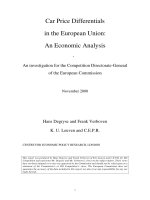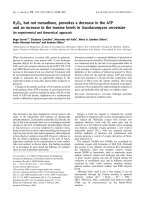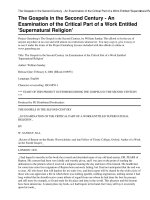Extension management approaches prevailed in the voluntary organization – An analysis
Bạn đang xem bản rút gọn của tài liệu. Xem và tải ngay bản đầy đủ của tài liệu tại đây (319.76 KB, 7 trang )
Int.J.Curr.Microbiol.App.Sci (2017) 6(4): 363-369
International Journal of Current Microbiology and Applied Sciences
ISSN: 2319-7706 Volume 6 Number 4 (2017) pp. 363-369
Journal homepage:
Original Research Article
/>
Extension Management Approaches Prevailed in the
Voluntary Organization – An Analysis
D.V. Singh*
Senior Scientist, Krishi Vigyan Kendra, Kandhamal, OUAT,
Bhubaneswar, Odisha, India
*Corresponding author
ABSTRACT
Keywords
Approaches,
Extension
management, Rural
area, Voluntary
organization.
Article Info
Accepted:
02 March 2017
Available Online:
10 April 2017
Voluntary organizations are better suited to devote their efforts to foster steady growth in
the rural areas. Study has been undertaken in 17 voluntary organizations each in
Nabarangpur and Kandhamal districts of Odisha during the year 2014 to access the extent
of extension management approaches particularly on planning, empowerment, information
system, coordination, supervision, accountability, programme implementation and control
process. The findings revealed that 23.25 to 43% gaps were observed on different aspects
of functioning. Better management approaches were prevailed on planning and
coordination. Similarly, weaker approaches prevailed on accountability and information
system. Socio-personal characteristics of the staffs had not much influence in increasing
their capabilities. The voluntary organizations have to analyze their management
approaches prevailed, assess weaknesses and take appropriate measures to strengthen the
extension management system for successful implementation of programmes.
Introduction
managerial
efficiencies
suggested
programmes could not be implemented
successfully for which the present studies
have been designed to “Assess the extent of
extension management approaches prevailed
in the voluntary organizations”.
Management is the process of designing and
maintaining an environment in which
individuals work together in groups to
accomplish the desired goals efficiently
(Bhatt, 1995). The voluntary organizations
have been established with the basic
objectives of serving the rural community and
more particularly in remote areas. It has also
been time tested that the voluntary
organizations are better suited to devote their
efforts to foster steady growth in the rural
areas (Yousuf et al., 2010). Government
machineries have also supported and
involving voluntary organizations to assist in
the developmental programmes for the
upliftment of the rural poor. Unless the
voluntary organizations have extension
Materials and Methods
The study was undertaken with 17 voluntary
organizations each from Nabarangpur and
Kandhamal district of Odisha. One personnel
each from administrative, supervisory and
field staffs were randomly selected as the
respondents
from
each
voluntary
organizations making total sample size of
102. Approaches prevailed on planning,
363
Int.J.Curr.Microbiol.App.Sci (2017) 6(4): 363-369
empowerment,
information
system,
coordination, supervision, accountability,
programme implementation and control
process were selected as the variables for the
study. Information collected on four point
scale as very often, often, occasionally and
never was analyzed with statistical measures.
management of information system is of
paramount
importance
in
successful
implementation of the activities undertaken.
The study revealed (Table 3) that significant
gaps were observed in the voluntary
organizations of both the district on
management of different aspects of
information system which conclude that the
voluntary organizations are giving weightage
towards implementation of the activities to
achieve the targets for which the impact might
not be significant.
Results and Discussion
Planning lies at the basic of all other
managerial functions. Effective planning
facilitates timely execution of tasks, provides
cooperative and coordinated efforts and
makes programme implementation easier. It is
observed (Table 1) that the respondents of
both the districts were at similar opinion as
per the Critical Ratio Value. Management
approaches prevailed in the voluntary
organizations of Kandhamal district was
better than Nabarangpur district. Pooled mean
score value revealed that the voluntary
organizations have to further strengthened the
management approaches since more than 20%
gaps were observed on different aspects of
planning.
Any staff in the organization has to deliver
satisfactorily to the job assigned. They have
to well acquainted with the environment,
develop sincerity, dedication as well as
devotion mind and assume responsibility.
Therefore accountability is one of the
important
factors
for
successful
implementation
of programmes.
But;
significant gap of about 40% were observed
(Table 4) on the management approaches
towards accountability by the staffs. But the
staffs of the voluntary organizations in both
the districts were not opined favorably for the
acceptance of failures by the head of the
organization. Poor responses were also
observed on inadequate facilities, insufficient
attention to weaker staffs and no appreciation
for good work. Unless this approach not
exists, staffs cannot assume responsibility and
sincerity will not be ascertained.
Empowerment of the staffs is the pre-requisite
for successful implementation of activities.
The findings revealed that (Table 2) no
significant difference was observed in the
management approaches on planning among
the voluntary organizations of both the
district.
Voluntary organizations are functioning
usually on external funding. The staffs
employed do not have much technical
competency. Therefore, they have to establish
strong
coordination
with
related
developmental organizations. But the findings
reveal (Table 5) that no significant differences
were observed on the coordination approaches
prevailed in the voluntary organizations
although
voluntary
organizations
of
Kandhamal district had better coordination
approaches than Nabarangpur district.
However, considerable gap of 20-30%
indicated that the voluntary organization have
to further strengthened the capabilities of the
staffs particularly on exposing staffs to latest
developments, believe their ability in success,
expand their vision, provide guidance as well
as direction and empowered them to manage
the assigned responsibilities.
Voluntary organizations usually depend on
the public sector organizations for
technological
backstopping.
Therefore,
364
Int.J.Curr.Microbiol.App.Sci (2017) 6(4): 363-369
Table.1 Management approaches prevailed on planning
Sl.
No
1
2
3
4
5
6
Approach
Nabarangpur
District
Mean Gap
score (%)
Setting long and short term goal 2.65
33.75
Participatory action plan
3.00
25.00
Clearly explaining role of each 3.04
24.00
staff
Exploring resources
3.02
24.50
Makes thorough understanding 3.00
25.00
on programme
Provide alternate solutions
3.12
22.00
Kandhamal
District
Mean Gap
score (%)
3.00
25.00
3.22
19.50
3.37
15.75
Pooled Gap
Mean (%)
score
C.R.
Value
2.83
3.11
3.21
29.25
22.25
19.75
2.11
1.27
1.87
3.24
3.00
19.00
25.00
3.13
3.0
21.75
25.00
1.26
0.00
3.14
21.50
3.13
21.75
0.11
Table.2 Approaches prevailed on empowerment of staffs
Sl.
No
Approach
1
2
3
4
5
6
Expose to latest developments
Expand their vision
Climate of team work
Provides guidance and direction
Sharing information
Believe their ability in success
Nabarangpur
District
Mean Gap
score (%)
2.59
35.25
3.06
23.50
3.04
24.00
2.67
33.25
3.02
24.50
2.59
35.25
Kandhamal
District
Mean Gap
score (%)
2.80
30.00
2.61
34.75
3.25
18.75
3.00
25.00
3.27
18.25
3.00
25.00
Pooled
Mean
score
Gap
(%)
C.R.
Value
2.70
2.84
3.15
2.84
3.15
2.80
32.50
29.00
21.25
29.00
21.25
30.00
1.30
2.71
0.92
1.99
1.43
2.49
Table.3 Approaches prevailed on management of information system
Sl.
No
Approach
1
Strong
mechanism
receiving information
Information transmitted to all
staffs
Information well understood
by staffs
Mechanism
for
storing
information for reference
Staff empowered in collection
and use of information
2
3
4
5
Nabarangpur
District
Mean Gap
score (%)
for 2.94
26.50
Kandhamal
District
Mean Gap
score (%)
3.00
25.00
Pooled Gap
Mean (%)
score
C.R.
Value
2.97
25.75
0.35
2.61
34.75
2.53
36.75
2.57
35.75
0.51
2.41
39.75
3.08
23.00
2.75
31.25
4.10*
2.33
41.75
2.80
30.00
2.57
35.75
2.97
2.20
45.00
2.65
33.75
2.43
39.25
2.92
*significant 0.05 level
365
Int.J.Curr.Microbiol.App.Sci (2017) 6(4): 363-369
Table.4 Management approaches prevailed on accountability
Sl.
No
1
2
3
4
5
Approach
Nabarangpur
District
Mean Gap
score (%)
Each staff assume responsibility 1.80
55.00
Appreciation for good work
2.16
46.00
Adequate facilities to staffs
2.22
44.50
More attention to weaker staffs 2.22
44.50
Head accepts failures
1.47
62.25
Kandhamal
District
Mean Gap
score (%)
2.90 27.50
2.76 31.00
2.37 40.75
2.61 34.75
2.24 44.00
Poole
d
Mean
score
2.35
2.46
2.30
2.42
1.86
Gap
(%)
C.R.
Value
41.25
38.50
42.50
39.50
53.50
3.08*
2.72
3.13*
2.81
8.09**
Kandhamal
District
Mean Gap
score (%)
2.87 29.00
Pooled Gap
Mean (%)
score
C.R.
Value
2.71
32.25
1.79
3.22
19.50
3.11
22.25
1.27
2.75
31.25
2.75
31.25
0.06
3.27
18.25
3.23
19.25
0.85
3.35
16.25
3.23
19.25
1.41
3.14
21.50
3.07
23.25
0.81
*significant at 0.05 level, **significant 0.01 level
Table.5 Management approaches prevailed on coordination
Sl.
No
1
2
3
4
5
6
Approach
Nabarangpur
District
Mean Gap
score (%)
Establish good linkage with 2.55
36.25
district machinery
Coordinate all activities for 3.00
25.00
optimum resource utilization
Setting coordination for broad 2.76
31.25
range of goals
Developing internal coordination 3.12
22.00
matrix
Establishing system of sharing 3.10
22.50
information
Developing standards for better 3.00
25.00
coordination
Table.6 Management approaches prevailed on supervision
Sl.
No
Approach
1
2
3
4
5
6
Preparing supervision schedule
Periodic performance appraisal
Attention for quality work
Managing problems and conflict
Encourage staffs for suggestions
Creating working environment
*significant at 0.05 level,
Nabarangpur
District
Mean Gap
score (%)
2.20
45.00
2.14
46.50
2.96
26.00
3.10
22.50
3.02
24.50
2.61
34.75
**significant at 0.01 level
366
Kandhamal
District
Mean Gap
score (%)
2.82
29.50
3.24
19.00
3.00
25.00
3.00
25.00
3.16
21.00
2.86
28.50
Pooled Gap
Mean (%)
score
C.R.
Value
2.51
2.69
2.98
3.05
2.89
2.74
3.96*
6.80**
0.24
0.58
0.81
2.68
37.25
32.75
25.50
23.75
27.75
31.50
Int.J.Curr.Microbiol.App.Sci (2017) 6(4): 363-369
Table.7 Management approaches prevailed on programme implementation
Sl.
No
1
2
3
4
5
6
Approach
Nabarangpur
District
Mean Gap
score (%)
Pre-arrangement of inputs / materials
1.80
55.00
Distributing responsibilities among 3.04
23.50
staffs
Closely monitoring each activities
3.00
25.00
Providing necessary guidance
2.98
25.50
Adequate mobility to staffs
3.06
23.50
Solving inconveniency
3.14
21.50
Kandhamal
District
Mean Gap
score (%)
2.48
37.75
3.00
25.00
Pooled Gap
Mean (%)
score
C.R.
Value
2.14
3.02
46.50
24.50
4.76*
0.23
3.18
3.27
3.06
3.00
3.09
3.13
3.06
3.07
22.75
21.75
23.50
23.25
1.04
1.67
0.00
0.81
20.50
18.25
23.50
25.00
*significant at 0.05 level
Table.8 Management approaches prevailed on control process
Sl.
No
1
2
3
4
5
6
Approach
Nabarangpur
District
Mean Gap
score (%)
Clarity on long term direction
3.00
25.00
Modifying goals and objectives as per 2.82
29.50
the situation
Thinks for least cost standards
3.00
25.00
Maintaining vertical and horizontal 1.00
75.00
linkage
Framing yardsticks to detect failures
3.02
24.50
Balancing
socio-organizational 3.00
25.00
development
Kandhamal
District
Mean Gap
score (%)
3.27
18.25
3.16
21.00
Pooled
Mean
score
Gap
(%)
C.R.
Value
3.14
2.99
21.50
25.25
1.55
2.00
3.00
2.53
25.00
36.75
3.00
1.77
25.00
55.75
0.00
11.60
2.59
3.37
35.25
15.75
2.81
3.19
29.75
20.25
2.60
2.11
**significant at 0.01 level
Table.9 Comparative analysis on prevalence of management approaches
Sl.
No
Approach
1
2
3
4
5
6
7
8
Planning
Staff empowerment
Information system
Accountability
Coordination
Supervision
Programme implementation
Control process
Nabarangpur
District
Mean Gap
score
(%)
2.97
25.75
2.83
29.25
2.50
37.50
1.97
50.75
2.92
27.00
2.67
33.25
2.84
29.00
2.64
34.00
367
Kandhamal
District
Mean Gap
score
(%)
3.16
21.00
2.99
25.25
2.81
29.75
2.58
35.50
3.10
22.50
3.01
24.75
3.00
25.00
2.99
25.25
Pooled Gap
Mean (%)
score
3.07
2.91
2.66
2.28
3.01
2.78
2.92
2.81
23.25
27.25
33.50
43.00
24.75
30.50
27.00
29.75
Int.J.Curr.Microbiol.App.Sci (2017) 6(4): 363-369
Table.10 Influence of socio-personal variables on management approaches
Sl.
No
1
2
3
4
5
6
7
8
Approach
Planning
Staff
empowerment
Information
system
Accountability
Coordination
supervision
Programme
implementation
Control process
*significant at 0.05 level,
Age
„r‟
-0.167
-0.140
„t‟
1.694
1.424
Education
„r‟
„t‟
0.075
0.752
0.339** 3.603
Experience
„r‟
„t‟
-0.310** 3.260
-0.192* 1.957
Training
„r‟
-0.055
0.092
„t‟
0.551
0.924
0.046
0.460
-0.332** 3.521
-0.114
1.148
-0.060
0.600
0.128
-0.515**
-0.213
0.062
1.290
6.009
2.180
0.621
-0.265*
0.027
-0.385**
0.112
2.749
0.270
4.171
1.127
0.323**
0.395**
-0.198*
0.115
3.414
4.298
2.020
1.158
0.162
-0.218*
-0.070
0.324**
1.641
2.234
0.700
3.425
0.264*
2.736
-0.194*
1.978
-0.276*
2.872
-0.615**
7.795
**significant at 0.01 level
At the same time, coordination within the
voluntary organizations was comparatively
better than outside organizations. However,
considerable gap of about 20% and more
suggested for further strengthening of
coordination approaches succeeding for
successful implementation of all activities.
differences were observed (Table 7) on
various management approaches prevailed in
the voluntary organizations of Nabarangpur
and Kandhamal districts. Comparatively
better management approaches were prevailed
on providing necessary guidance, closely
monitoring each activity followed by solving
inconveniences, adequate mobility and
distributing responsibilities among staffs.
Though pre-management of inputs and
materials are the pre-requisite for successful
implementation of programme, but poor
responses observed indicated the deficiencies.
On the whole, considerable gap of more than
20% in different aspects suggested for further
strengthening of the management system for
better programme implementation.
Supervision is an essential part of any
organization which substitutes for leadership,
authority and contribute to the attainment of
the objectives. Significant differential
opinions (Table 6) were observed on
preparing supervision schedule and periodic
performance appraisal indicated that these
management approaches not prevailed in all
the voluntary organizations. Although, better
management approaches prevailed on
managing problems and conflicts as well as
encouraging staffs for suggestions, but
considerable Gap of 24% and more in all the
approaches
suggested
for
further
strengthening ensuring better supervision
system.
Each
organization
has
to
establish
performance
standards
along
with
measurement procedure, assessing deviations
and provide corrective measures to create
good working environment which otherwise
called as the control process. Data in table 8
reveal that maintaining vertical and horizontal
linkages and insufficient approach for framing
yardsticks to detect failures were lacking in
the voluntary organizations. Although
satisfactory approaches prevailed on other
Effective implementation of programmes is
the ultimate goal for which all management
approaches have to be extended to the staffs
of the voluntary organizations. No significant
368
Int.J.Curr.Microbiol.App.Sci (2017) 6(4): 363-369
aspects, but considerable gap of more than
20% revealed for further strengthening in
management approaches on control process.
management approaches were prevailed on
planning and coordination. Similarly weaker
approaches were prevailed on accountability
and information system Socio-personal
variables of the respondents had also not
much influence in increasing capabilities in
various extension management approaches.
Moreover, 20 to 34% deficiencies were
observed in the management approaches. The
study therefore, conclude that the voluntary
organizations have to analyze their existing
management
approaches,
assess
the
weaknesses and take appropriate measures to
strengthen the extension management system
enabling to implement various activities
successfully.
Comparative analysis of the management
approaches prevailed in the voluntary
organizations indicated that (Table 9)
voluntary organizations in Kandhamal district
had better management approaches than
Nabarangpur district. Better management
approaches were prevailed on planning and
coordination and weakest approaches on
accountability as well as information system
in comparison to other approaches. However,
considerable deficiencies of 23 to 43% in
different approaches suggested for further
strengthening of extension management
system by the voluntary organizations.
References
Acquiring knowledge and developing
competency are the function of economic,
socio-psychological and communication
factors. Correlation co-efficient analysis
revealed that (Table 10) age, education,
experience and training exposure of the
respondents had not much influence on
increasing their competency in the extension
management system. However, education,
experience and training had either positive or
negative influence on various extension
management approaches.
Bhatt, A. 1995. Voluntary action in India:
Roles,
trends
and
challenges,
Economics and Political weekly, 30:
870-873.
Elliot, C. 1987. Some aspects of relations
between North and South in the NGO
sector, World Develop., 15 (suppl): 5768.
Subramanian, V. 1977. Rural Development:
The administrative imperatives, Rural
Development,
Bombay,
India
Merchants Chamber, Pp 23-28.
Yousuf, M., Imran, A.M.T., Sawar, M. and
Naseeruddin,
M.
2010.
Nongovernment organization‟s service
quality for development of basic
education in Pakistan, Africa J.
Business Manage., 4(14): 3201-3206.
The study on “Extension management
approaches prevailed in the voluntary
organizations” revealed that voluntary
organizations in Nabarangpur district had
better
management
approaches
than
Kandhamal district. In general, better
How to cite this article:
Singh, D.V. 2017. Extension Management Approaches Prevailed in the Voluntary Organization
– An Analysis. Int.J.Curr.Microbiol.App.Sci. 6(4): 363-369.
doi: />
369









